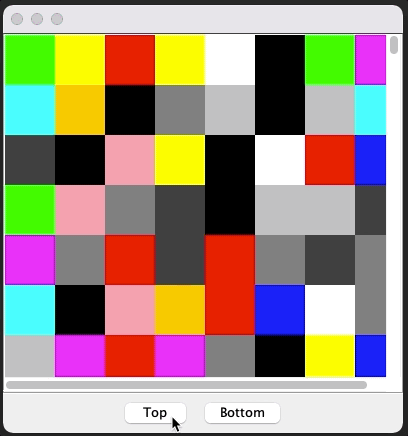Here is my code for the ScrollPane
public class CustomScrollPane extends JScrollPane {
private static CustomScrollPane instance = null;
public CustomScrollPane () {
super(panel.getInstance()); // a panel that the scrollpane wraps around
this.setVerticalScrollBarPolicy(JScrollPane.VERTICAL_SCROLLBAR_ALWAYS);
// hide the vertical scroll bar
this.getVerticalScrollBar().setPreferredSize(new Dimension(0, 0));
}
public static CustomScrollPane getInstance() {
if (instance == null)
instance = new CustomScrollPane ();
return instance;
}
I tried to do getVerticalScrollbar.setValue(getVerticalScrollbar().getMaximum()) but it does not scroll to the end when I add JLabels to it. I’m trying to make it so that it will always scroll to the bottom of the screen once a new JLabel gets added to the panel. I din’t use JTextArea as I want each line to have a different foreground color, so I used JLabels.
I also tried adding this method
public void scrollToBottom() { getVerticalScrollbar().getMaximum(); }
but it just freezes the ScrollPane and I am unable to scroll.
Any help would be appreciated!
Advertisement
Answer
I’m not sure what you hope to achieve by extending JScrollPane, not sure that it’s really its core responsibility, after all, you could have its “viewport view” do it itself, for example…
import java.awt.BorderLayout;
import java.awt.Color;
import java.awt.Dimension;
import java.awt.EventQueue;
import java.awt.GridLayout;
import java.awt.Rectangle;
import java.awt.event.ActionEvent;
import java.awt.event.ActionListener;
import java.util.ArrayList;
import java.util.Arrays;
import java.util.Collections;
import java.util.List;
import javax.swing.JButton;
import javax.swing.JFrame;
import javax.swing.JPanel;
import javax.swing.JScrollPane;
public class Main {
public static void main(String[] args) {
new Main();
}
public Main() {
EventQueue.invokeLater(new Runnable() {
@Override
public void run() {
JFrame frame = new JFrame();
frame.add(new TestPane());
frame.pack();
frame.setLocationRelativeTo(null);
frame.setVisible(true);
}
});
}
public class TestPane extends JPanel {
public TestPane() {
setLayout(new BorderLayout());
JPanel contentPane = new JPanel(new GridLayout(-1, 8));
for (int index = 0; index < 1000; index++) {
contentPane.add(new SqaurePane());
}
add(new JScrollPane(contentPane));
JButton top = new JButton("Top");
JButton bottom = new JButton("Bottom");
JPanel actionPane = new JPanel();
actionPane.add(top);
actionPane.add(bottom);
add(actionPane, BorderLayout.SOUTH);
top.addActionListener(new ActionListener() {
@Override
public void actionPerformed(ActionEvent e) {
contentPane.scrollRectToVisible(new Rectangle(0, 0, 1, 1));
}
});
bottom.addActionListener(new ActionListener() {
@Override
public void actionPerformed(ActionEvent e) {
contentPane.scrollRectToVisible(new Rectangle(0, contentPane.getHeight(), 0, 0));
}
});
}
@Override
public Dimension getPreferredSize() {
return new Dimension(400, 400);
}
}
static List<Color> COLORS = new ArrayList<>(Arrays.asList(new Color[] {
Color.BLACK,
Color.BLUE,
Color.CYAN,
Color.DARK_GRAY,
Color.GRAY,
Color.GREEN,
Color.LIGHT_GRAY,
Color.MAGENTA,
Color.ORANGE,
Color.PINK,
Color.RED,
Color.WHITE,
Color.YELLOW,
}));
public class SqaurePane extends JPanel {
public SqaurePane() {
Collections.shuffle(COLORS);
setBackground(COLORS.get(0));
}
@Override
public Dimension getPreferredSize() {
return new Dimension(50, 50);
}
}
}
The magic is right here…
top.addActionListener(new ActionListener() {
@Override
public void actionPerformed(ActionEvent e) {
contentPane.scrollRectToVisible(new Rectangle(0, 0, 1, 1));
}
});
bottom.addActionListener(new ActionListener() {
@Override
public void actionPerformed(ActionEvent e) {
contentPane.scrollRectToVisible(new Rectangle(0, contentPane.getHeight(), 0, 0));
}
});
Here, I’m asking the contentPane (which is the container holding all the squares) to “scroll to a visible rectangle” based on my needs
Now, in you case, when you add a new component to the “container”, you would need to instruct the component to scroll to a position which would show the new component.
This is going to be a little more complicated as you will need to trigger a layout pass first, so you can get the new size of the container
Dynamic addition to the container…
import java.awt.BorderLayout;
import java.awt.Color;
import java.awt.Dimension;
import java.awt.EventQueue;
import java.awt.GridLayout;
import java.awt.Rectangle;
import java.awt.event.ActionEvent;
import java.awt.event.ActionListener;
import java.util.ArrayList;
import java.util.Arrays;
import java.util.Collections;
import java.util.List;
import javax.swing.JFrame;
import javax.swing.JPanel;
import javax.swing.JScrollPane;
import javax.swing.Timer;
public class Main {
public static void main(String[] args) {
new Main();
}
public Main() {
EventQueue.invokeLater(new Runnable() {
@Override
public void run() {
JFrame frame = new JFrame();
frame.add(new TestPane());
frame.pack();
frame.setLocationRelativeTo(null);
frame.setVisible(true);
}
});
}
public class TestPane extends JPanel {
public TestPane() {
setLayout(new BorderLayout());
JPanel contentPane = new JPanel(new GridLayout(-1, 8));
add(new JScrollPane(contentPane));
for (int index = 0; index < 8 * 8; index++) {
contentPane.add(new SqaurePane());
}
Timer timer = new Timer(500, new ActionListener() {
@Override
public void actionPerformed(ActionEvent e) {
SqaurePane sqaurePane = new SqaurePane();
contentPane.add(sqaurePane);
contentPane.revalidate();
// There is an issue with how the layout pass runs, this
// "seems" to be getting pushed onto the EDT later, which
// is messing up the scroll logic.
// So, instead, we push this on to the EDT to be executed
// "later" after the layout pass has run. Yes, I tried
// calling doLayout directly, but, for the first element
// of each row, it wouldn't work correctly
EventQueue.invokeLater(new Runnable() {
@Override
public void run() {
contentPane.scrollRectToVisible(new Rectangle(0, sqaurePane.getY(), 1, sqaurePane.getHeight()));
}
});
}
});
timer.start();
}
@Override
public Dimension getPreferredSize() {
return new Dimension(400, 400);
}
}
static List<Color> COLORS = new ArrayList<>(Arrays.asList(new Color[]{
Color.BLACK,
Color.BLUE,
Color.CYAN,
Color.DARK_GRAY,
Color.GRAY,
Color.GREEN,
Color.LIGHT_GRAY,
Color.MAGENTA,
Color.ORANGE,
Color.PINK,
Color.RED,
Color.WHITE,
Color.YELLOW,}));
public class SqaurePane extends JPanel {
public SqaurePane() {
Collections.shuffle(COLORS);
setBackground(COLORS.get(0));
}
@Override
public Dimension getPreferredSize() {
return new Dimension(50, 50);
}
}
}
Now, if you really wanted to decouple the concept, you could us a ContainerListener and react to the new component been added via it
